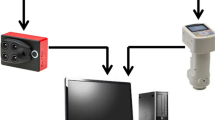Abstract
Intercomparisons are made between three spectrally filtered photographs of experimental burns on guinea pigs and accidental burns on humans. The original photographs are taken on Kodak 35 mm Plus X and High Speed Infrared films. The transparencies are digitized and processed by a computer to form three additional photographs, each of which has an optical density proportional to the ratio of the target spectral reflectances. These images are color processed to form a pseudo color photograph which indicates the relative magnitude of the spectral reflectance ratio of the injured tissue. It is shown that these ratios, displayed by color patterns, have potential diagnostic value for the determination of burn depth in man.
Similar content being viewed by others
References
Anselmo, V. J., and Zawacki, B. E. Infrared photography as a diagnostic tool for the burn ward.Proceedings of the Society of Photo-Optical Instrumentation Engineers, Quantitative Imagery in the Biomedical Sciences—II 1973,80, 181.
Goetz, A. F. H.,et al.Application of ERTS images and image processing to regional geologic problems and geologic mapping in Northern Arizona. TR-32-1597. Pasadena, Calif.; Jet Propulsion Laboratory, 1975.
Hinshaw, J. R. Why burn severity is often misjudged.Archives of Surgery 1961,83, 81–85.
Jackson, D. MacG. Second thoughts on the burn wound.Journal of Trauma 1969,9, 839–862.
Jackson, D. MacG. A uniform classification of the depth of burns. In P. Matter, T. L. Barclay, and F. Konickova (Eds.),Research in burns. Bern: Huber, 1961, Pp. 713–714.
Jackson, D. MacG. The diagnosis of the depth of burning.British Journal of Surgery 1953,40, 588.
Janzekovic, Z. A new concept in the early excision and immediate grafting of burns.Journal of Trauma 1970,10, 1103–1108.
Monafo, W. W., Aulenbacher, C. E., and Pappalardo, C. Early tangential excision of the eschars of major burns.Archives of Surgery 1972,104, 503–508.
NIH Record, National Institute of Health. Feb.13, 1973, P. 4.
Selzer, R. H. The use of computers to improve biomedical image quality. InProceedings of the 1968 fall joint computer conference, 1968, Washington, D. C.: Thompson, 1968. Vol. 33, Part I, Pp. 818–834.
Sevitt, S.Burns, pathology and therapeutic applications, London: Butterworth, 1957, P. 19.
Walker, H. L., and Mason, A. D., Jr. A standard animal burn.Journal of Trauma 1968,8, 1049.
Zawacki, B. E. Reversal of capillary stasis and prevention of necrosis in burns,Annals of Surgery 1974,180, 98–102.
Author information
Authors and Affiliations
Additional information
This paper presents one phase of research performed by the Jet Propulsion Laboratory, California Institute of Technology, at the Los Angeles County/University of Southern California Medical Center, under Contract NAS 7-100, sponsored by the National Aeronautics and Space Administration, Office of Technology Utilization.
Rights and permissions
About this article
Cite this article
Anselmo, V.J., Zawacki, B.E. Multispectral photographic analysis a new quantitative tool to assist in the early diagnosis of thermal burn depth. Ann Biomed Eng 5, 179–193 (1977). https://doi.org/10.1007/BF02364018
Received:
Issue Date:
DOI: https://doi.org/10.1007/BF02364018




